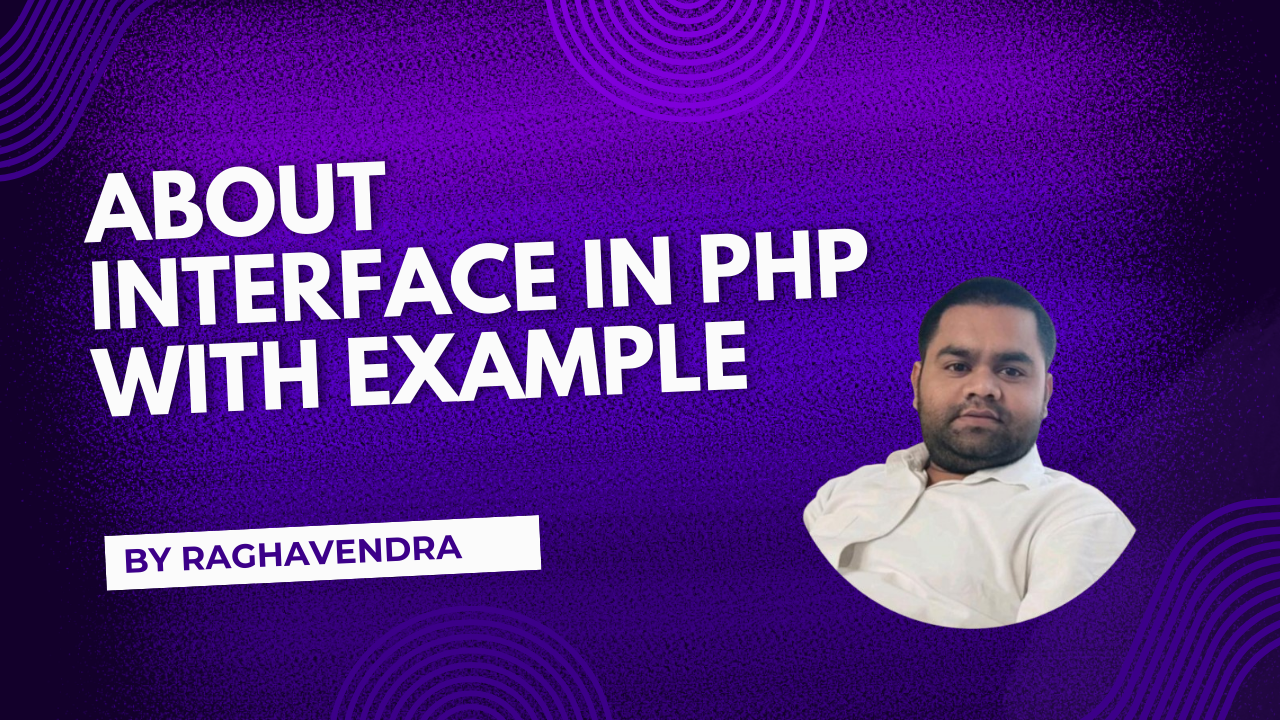About Interface in PHP with Example

Defining an Interface in PHP
To define an interface in PHP, you use the interface keyword. An interface can contain method signatures, but it cannot have any method bodies (i.e., no implementation). All methods in an interface are abstract, meaning they must be implemented by any class that implements the interface.
<?php
interface Animal {
public function makeSound(); // Abstract method (no implementation)
}
?>
Implementing an Interface
A class implements an interface by using the implements keyword. The class must provide concrete implementations for all the methods declared in the interface.
<?php
class Dog implements Animal {
public function makeSound() {
echo "Bark";
}
}
$dog = new Dog();
$dog->makeSound(); // Outputs: Bark
?>
Key Characteristics of Interfaces in PHP
No Method Implementation: Interfaces in PHP only declare method signatures, without providing any implementation. The implementing class is responsible for defining the behavior of these methods.
Cannot Instantiate: You cannot create instances of an interface directly. It only serves as a blueprint for the classes that implement it.
Methods Must Be Public: All methods declared in an interface are implicitly public. Therefore, methods in the implementing class must also be public to match the interface's accessibility.
No Property/Attributes: Interfaces cannot have properties or instance variables. They can only declare method signatures.
Example of Multiple Interfaces
A class can implement multiple interfaces, which allows it to inherit behavior from multiple sources. In PHP, this is supported directly.
<?php
interface Animal {
public function makeSound();
}
interface Swimable {
public function swim();
}
class Dog implements Animal, Swimable {
public function makeSound() {
echo "Bark";
}
public function swim() {
echo "Dog swims";
}
}
$dog = new Dog();
$dog->makeSound(); // Outputs: Bark
$dog->swim(); // Outputs: Dog swims
?>
Interface Inheritance
An interface can extend another interface, which allows the inheriting interface to inherit the method signatures from the parent interface. A class that implements the child interface must implement all the methods of both the parent and child interfaces.
<?php
interface Animal {
public function makeSound();
}
interface Mammal extends Animal {
public function giveBirth();
}
class Dog implements Mammal {
public function makeSound() {
echo "Bark";
}
public function giveBirth() {
echo "Giving birth to puppies";
}
}
$dog = new Dog();
$dog->makeSound(); // Outputs: Bark
$dog->giveBirth(); // Outputs: Giving birth to puppies
?>
Interface Constants
Interfaces can also define constants, which can be used by implementing classes. Constants defined in an interface are automatically public and cannot be changed by the implementing classes.
<?php
interface Animal {
const TYPE = "Mammal";
public function makeSound();
}
class Dog implements Animal {
public function makeSound() {
echo "Bark";
}
}
echo Dog::TYPE; // Outputs: Mammal
?>
Advantages of Using Interfaces in PHP
Decoupling: Interfaces provide a way to decouple code. You can change the implementation of a method in one class without affecting others that rely on the interface.
Flexibility: Multiple classes can implement the same interface in different ways, providing flexibility in how you can design your system.
Polymorphism: Different classes implementing the same interface can be treated interchangeably. This is particularly useful when you want to write code that can work with any class that implements a given interface, without worrying about the specific class.
Improved Design: Using interfaces forces you to think in terms of contracts, which can improve the design and structure of your application.
Real-World Example: Payment System
Suppose you are building an e-commerce application, and you want to create different payment methods (like PayPal, CreditCard, etc.). Instead of writing separate code for each payment method, you can define a PaymentMethod interface with a processPayment method. Each payment class will implement this interface, ensuring that they all have the same method, even though their implementation may differ.
<?php
interface PaymentMethod {
public function processPayment($amount);
}
class PayPal implements PaymentMethod {
public function processPayment($amount) {
echo "Processing PayPal payment of $$amount";
}
}
class CreditCard implements PaymentMethod {
public function processPayment($amount) {
echo "Processing Credit Card payment of $$amount";
}
}
$payment = new PayPal();
$payment->processPayment(100); // Outputs: Processing PayPal payment of $100
$payment = new CreditCard();
$payment->processPayment(200); // Outputs: Processing Credit Card payment of $200
?>
Summary
In PHP, an interface is a powerful feature used to define a common contract that classes must adhere to. It ensures consistency across different classes and allows for flexibility and decoupling. By defining interfaces, you can implement polymorphic behavior, where different classes can be treated the same way as long as they implement the same interface. Interfaces help in maintaining clean and modular code and are a key aspect of object-oriented programming in PHP.




